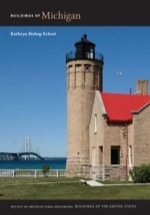
In 1939 an oil boom brought an influx of people to Gladwin County and eased the economic burdens of the Great Depression in central Michigan. At the same time, the state removed a severance tax on crude oil and returned it to the county for a municipal purpose. These economic developments prompted all sixteen supervisors of Gladwin County to agree that they should build a new courthouse. The reinforced-concrete Moderne building was designed by a Royal Oak architect. The rectangular, flat-roofed, light yellowish-brown brick building has a heavy and monumental balanced symmetry. The exterior is ornamented with cut stone panels set beneath the upper windows. They are carved in intaglio and contain local scenes of lumbering, farming, dairying, oil production, hunting, and skiing. The scenes are simplified and stylized, with the major forms carved most broadly. Township names are incised in stones that run along a water table above the building's foundation. The Art Deco lobby is finished with a chamfered ceiling painted with zigzags and a floor inlaid with the image of a head of a Native American. Charles C. Englehardt constructed the courthouse.














